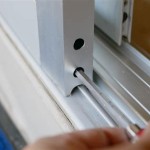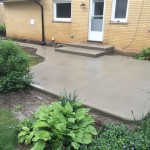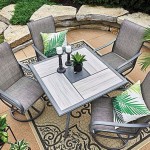Porcelain Tiles For Outdoor Patio: A Comprehensive Guide
Outdoor patios serve as valuable extensions of living spaces, offering areas for relaxation, entertainment, and dining. Selecting appropriate materials for patio construction is crucial, considering factors such as durability, aesthetics, slip resistance, and maintenance requirements. Porcelain tiles have emerged as a popular choice for outdoor patios due to their inherent properties and versatility. This article provides a comprehensive overview of porcelain tiles for outdoor patios, delving into their advantages, types, installation considerations, maintenance practices, and design possibilities.
Porcelain tiles are a type of ceramic tile composed of fine-grained clay, silica, and feldspar. These materials are subjected to high temperatures and pressures during the manufacturing process, resulting in a dense, impermeable, and exceptionally durable product. The manufacturing process for porcelain tiles differentiates them from other ceramic tiles. Porcelain tiles are fired at higher temperatures, resulting in a harder, less porous material that is more resistant to water absorption, staining, and frost damage. These characteristics make porcelain tiles particularly well-suited for outdoor applications, where they are exposed to varying weather conditions and potential wear and tear.
Key Advantages of Porcelain Tiles for Outdoor Patios
Porcelain tiles offer a multitude of advantages that make them a compelling choice for outdoor patio applications. These advantages contribute to their longevity, aesthetic appeal, and overall performance in outdoor environments.
Durability and Longevity: One of the primary advantages of porcelain tiles is their exceptional durability. Their dense composition and high firing temperatures result in a material that is resistant to cracking, chipping, and fading. This durability translates to a longer lifespan compared to other patio materials, reducing the need for frequent repairs or replacements. Porcelain tiles can withstand heavy foot traffic, furniture weight, and exposure to harsh weather conditions without significant degradation. This makes them an ideal choice for high-traffic outdoor spaces.
Water Resistance and Frost Resistance: Porcelain tiles exhibit very low water absorption rates, typically less than 0.5%. This inherent water resistance prevents water from penetrating the tile, which is crucial in preventing frost damage in colder climates. When water freezes within a porous material, it expands, potentially causing cracks and structural damage. The low water absorption rate of porcelain tiles mitigates this risk, ensuring their integrity even in freezing and thawing cycles. This characteristic is particularly important for patios located in regions with significant temperature fluctuations.
Slip Resistance: Safety is a paramount consideration for outdoor patios, especially in areas prone to wet conditions. Porcelain tiles are available in a variety of textures and finishes, allowing for the selection of slip-resistant options that enhance safety and prevent accidents. Textured surfaces, such as those with a slightly rough or matte finish, provide increased traction, reducing the likelihood of slips and falls. The slip resistance of porcelain tiles is often measured using a coefficient of friction (COF) rating, with higher COF values indicating greater slip resistance. Choosing tiles with an appropriate COF rating for the intended use and location of the patio is essential.
Low Maintenance: Porcelain tiles are remarkably easy to maintain, requiring minimal effort to keep them looking their best. Their non-porous surface resists staining and makes cleaning simple. Regular sweeping or vacuuming to remove debris and occasional washing with mild detergent and water are typically sufficient to maintain their cleanliness. Unlike some other patio materials, porcelain tiles do not require sealing or specialized treatments. This ease of maintenance contributes to their long-term cost-effectiveness and reduces the time and effort required for upkeep.
Aesthetic Versatility: Porcelain tiles are available in a seemingly endless array of colors, patterns, sizes, and textures. This vast selection allows for the creation of patios that complement any architectural style and personal aesthetic preferences. Porcelain tiles can mimic the look of natural stone, wood, concrete, and other materials, providing the desired aesthetic without the associated maintenance or cost. Digital printing technology enables manufacturers to create highly realistic and intricate designs on porcelain tiles, further expanding the design possibilities. This versatility allows homeowners and designers to create unique and personalized outdoor spaces.
Resistance to Staining and Fading: The dense and non-porous nature of porcelain tiles makes them highly resistant to staining from common outdoor substances such as spilled food and drinks, dirt, and leaves. Their resistance to fading ensures that their color and appearance remain vibrant over time, even when exposed to direct sunlight. This resistance to staining and fading contributes to their long-term aesthetic appeal and reduces the need for frequent cleaning or restoration.
Types of Porcelain Tiles Suitable for Outdoor Patios
While all porcelain tiles share certain fundamental characteristics, there are different types of porcelain tiles that are classified based on their manufacturing process, finish, and intended use. Selecting the appropriate type of porcelain tile is crucial for achieving the desired aesthetic and performance on an outdoor patio.
Through-Body Porcelain Tiles: Through-body porcelain tiles have the same color and pattern throughout their entire thickness. This means that if the tile is chipped or scratched, the underlying color will match the surface, making the damage less noticeable. This type of tile is particularly well-suited for high-traffic outdoor areas where wear and tear are more likely. Through-body porcelain tiles are often more durable than other types of porcelain tiles due to their consistent composition.
Glazed Porcelain Tiles: Glazed porcelain tiles have a layer of glaze applied to their surface. This glaze can be matte, glossy, or textured, and it provides additional protection against staining and water absorption. Glazed porcelain tiles are available in a wider range of colors and designs compared to through-body tiles. However, if the glaze is chipped or scratched, the underlying porcelain body will be exposed, which may be a different color. Selecting a high-quality glaze that is specifically designed for outdoor use is essential for ensuring the longevity and performance of glazed porcelain tiles.
Textured Porcelain Tiles: Textured porcelain tiles have a surface that is intentionally roughened or patterned to enhance slip resistance. These tiles are particularly well-suited for areas that are prone to wet conditions, such as around swimming pools or in regions with frequent rainfall. Textured porcelain tiles can mimic the look of natural stone or wood, adding visual interest and improving safety. The texture of the tile should be carefully considered to ensure that it provides adequate slip resistance without being too difficult to clean.
Paver Porcelain Tiles: Paver porcelain tiles are specifically designed for outdoor use. They are typically thicker and more durable than standard porcelain tiles, and they are often manufactured with interlocking edges for easy installation. Paver porcelain tiles are available in a variety of sizes, shapes, and colors, allowing for the creation of visually appealing and highly durable outdoor patios. They are often used in conjunction with a sand or gravel base for drainage and stability.
Installation and Maintenance Considerations
Proper installation and regular maintenance are essential for maximizing the lifespan and performance of porcelain tile patios. Adhering to best practices during installation and implementing a consistent maintenance routine will ensure that the patio remains both aesthetically pleasing and structurally sound for years to come.
Proper Substrate Preparation: The foundation upon which the porcelain tiles are laid is critical for its long-term stability. The substrate must be properly prepared to ensure a level, stable, and well-draining surface. This typically involves removing existing vegetation, compacting the soil, and installing a layer of gravel or crushed stone. A concrete slab can also be used as a substrate, but it must be properly cured and sealed before the tiles are installed. Proper slope is also important for adequate water runoff.
Choosing the Right Mortar and Grout: Selecting the appropriate mortar and grout is crucial for proper tile adhesion and water resistance. A polymer-modified mortar specifically designed for outdoor use is recommended. The grout should also be water-resistant and stain-resistant to prevent water penetration and unsightly staining. Epoxy grout is an excellent option for outdoor patios due to its superior durability and resistance to staining, chemicals, and water absorption.
Proper Tile Spacing and Grouting Techniques: Maintaining consistent tile spacing is essential for creating a uniform and aesthetically pleasing appearance. Using tile spacers during installation ensures even gaps between the tiles. Proper grouting techniques are also crucial for preventing water penetration and ensuring the stability of the tile installation. The grout should be carefully packed into the joints and then smoothed with a grout float. After the grout has cured, it should be sealed to protect it from staining and water damage.
Regular Cleaning: Regular cleaning is essential for maintaining the appearance of porcelain tile patios. Sweeping or vacuuming the patio regularly removes dirt and debris that can scratch or stain the tile surface. Occasional washing with mild detergent and water helps to remove stubborn stains and grime. Avoid using abrasive cleaners or scouring pads, as they can damage the tile surface.
Sealing the Grout: Sealing the grout helps to prevent water penetration and staining. The grout should be sealed annually or as needed, depending on the type of grout used and the level of exposure to the elements. A penetrating sealer is generally recommended for grout, as it will not change the appearance of the grout while providing effective protection.
Preventative Maintenance: Taking preventative measures can help to extend the life of porcelain tile patios. This includes promptly cleaning up spills, avoiding the use of harsh chemicals, and protecting the patio from heavy objects that could damage the tile surface. Regular inspection of the patio for cracks or loose tiles is also recommended. Addressing any issues promptly can prevent further damage and minimize the need for costly repairs.
By carefully selecting the appropriate type of porcelain tile, properly installing it, and implementing a consistent maintenance routine, homeowners can create beautiful, durable, and long-lasting outdoor patios that enhance their living spaces and provide years of enjoyment.

Porcelain Paver Backyard A Guide For Outdoor Tiles Stone Tile

The Complete Guide To Choosing Best Outdoor Tile

Outdoor Porcelain Tiles 8 Stunning Designs Stiled Com

Porcelain Paver Backyard A Guide For Outdoor Tiles Stone Tile
Is Porcelain Tile A Good Choice For Patio

Using Porcelain And Ceramic Tile In Outdoor Kitchens Why

Lifeproof Slip Resistant Porcelain Tile The Home

Transform Your Patio With Outdoor Tile Ideas And Inspiration Deluxe Bathrooms

Creating Gorgeous Patios With Outdoor Porcelain Tile

Outdoor Porcelain Tiles And Floor








